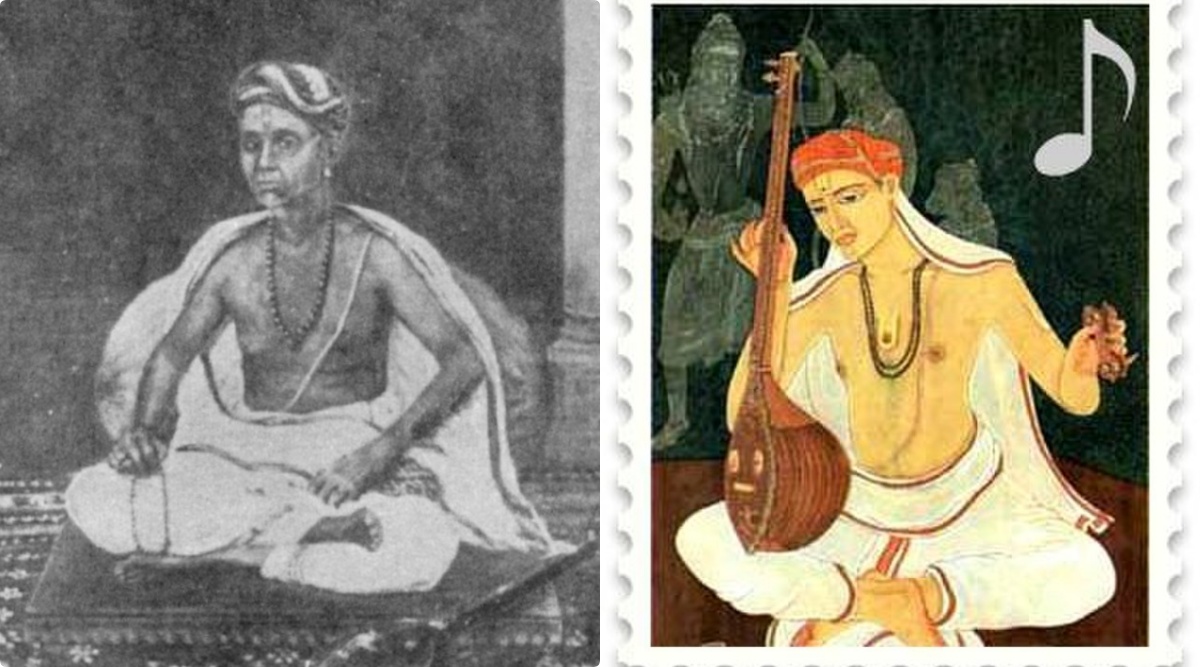 Tyagaraja was born on May 14, 1767, in the village of Thiruvayaru in Tamil Nadu's Thanjavur district. (Source: Wikicommons)
Tyagaraja was born on May 14, 1767, in the village of Thiruvayaru in Tamil Nadu's Thanjavur district. (Source: Wikicommons)During a farewell speech for the outgoing Rajya Sabha Chairman and Vice-President M Venkaiah Naidu in Parliament, Congress MP Jairam Ramesh on Monday highlighted that it was due to ‘Hindi imperialism’ that the name of the road where Naidu will be moving to was spelt incorrectly. He said the Tamil name Thyagaraja had become Thyagaraj in Delhi.
“I want to make a special request to you. You have been a champion of Indian languages. Who is this Thyagaraj? In Tamil, he is Thyagaraja. In Telugu, he is Tyagaraja. Why is he made Thyagaraj in Delhi? This is what ‘Hindi imperialism’ does,” said Ramesh.
Naidu responded by saying that it will be his personal endeavour to ensure that the name is changed. “Definitely, I will get it changed. Don’t worry. ‘Tyagaraja’ is a great musician. The people in Tamil Nadu and in Karnataka love his music,” said Naidu.
Who is Tyagaraja, the saint-poet of Carnatic music?
Born on May 14, 1767 in the village of Thiruvayaru in Tamil Nadu’s Thanjavur, Tyagaraja’s parents, Kakarla Ramabrahmam and Sitamma, were said to be Telugu Mulakanadu Smartha Brahmins from Prakasam in Andhra, whose parents migrated to the Tamil-speaking region. Tyagaraja was named Tyagabrahmam at birth, in honour of lord Shiva who is worshipped as Tyagaraja in the temple at his birthplace.
Subscriber Only Stories
He is widely regarded as one of three major composers – known as the Trinity – of Carnatic Music who flourished at Tanjore or Thanjavur in the early 19th century, the others being Muthuswami Dikshitar and Syama Sastri.
Tyagaraja is said to have composed the music and penned the lyrics of thousands of kritis, mostly in praise of lord Rama, who is believed to be an incarnation of the god Vishnu. He is known to have created musical innovations, including the use of a structured variation of musical lines within a performance, a practice that may have been derived from improvisatory techniques.
As Suddhananda Bharathi, an Indian philosopher and poet, noted, “Tyagaraja is the temple of Ram Nam – Ram Kokilam – who warbles the glory of Rama from honey-dropping arbor of music. He is a Mira in motion, a Kabir in devotion, a Purandara Dasa in music and a Nammalwar in vision.”
In the book The Spiritual Heritage of Tyagaraja , author Dr V Raghavan, wrote: “The age of Chaturdandi, of Gita, Prabandha, Thaya and Alapa had to give place to the age of Pada, Kirtana and Krithi. In achieving this, Tyagaraja stands foremost with his marvellous contribution… In sheer volume of output, he essays in the direction of Purandara Dasa and Kshetragna; In devotion, religious fervour, reformatory zeal and spiritual realisation, his songs approach those of Purandara Dasa; when we think of him singing to his Rama in anguish, we find in him a second Ramadas of Badrachala; in his lyrical moods he takes a page off Kshetragna; in his Pancharatnas and some of his heavier compositions, he treads the path of the earlier prabandha-karas and later varna-karas; in turning out pieces now and then in the language of the Gods, he seems to beckon his contemporary Dikshitar; when he sings of Mother Tripurasundari, it appears as if Syama Sastri of Tanjore was sojourning at Tiruvotriyur; and he could sustain himself through the task of a dramatic composition like Narayana Tirtha or Merattur Venkatarama Bhagavathar and pay his homage to a sampradaya sanctified by Jayadeva.”
Tyagaraja’s compositions or kritis
Tyagaraja’s compositions are well-known and remarkable not only for their immense volume but also for their variety and quality. “The highest musical excellence is found in his compositions which we have come to call kritis, in which he captured and effectively picturised the essence of ragas… there is a wide variety of form and type from metrical compositions and settings to creations like ‘Koluvaiyunnade’ (Devagandari) where sangatis are heaped and the sahityas are moulded like Pallavis” said Dr Raghavan.
In addition to individual pieces, he composed ‘Uthsava Sampradaya Kirtanas’ and ‘Divyanama Sankirtanas’ for adoption in bhajans and festivals. The Pancharatna Kritis, one of the most famous compositions by Tyagaraja are remembered even today and sung together by Carnatic musicians all over the world as an offering from musicians and music lovers to the spirit of Tyagaraja.
Dr Raghavan, in his book, said: “If gold could be found with fragrance, it is Tyagaraja, Kshetragna, Purandara Dasa or Jayadeva.”
As a mark of respect and thanksgiving to Tyagaraja, Carnatic musicians from all over the globe get together and pay their respects to the poet, who is also revered as a saint, by singing the Pancharatna kritis on the Pushya Bahula Panchami day (when he attained Samadhi). There are several musical festivals that are conducted around the globe in his name, but the most popular one is Tyagaraja Aradhana, conducted at Thiruvayaru between the months of January and February every year. The festival features hundreds of vocalists and instrumentalists from different parts of south India.
Two films have been made on Tyagaraja’s life – ‘Thyagaiah’ in 1946 by Chittor V Nagaiah and another one by the same name in 1981 by Bapu, also referred to as Ramana. Tyagaraja passed away on January 6, 1847. However, not much is known about the last days of his life.
- The Indian Express website has been rated GREEN for its credibility and trustworthiness by Newsguard, a global service that rates news sources for their journalistic standards.

